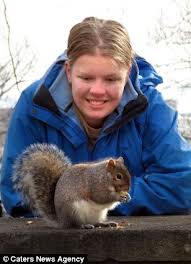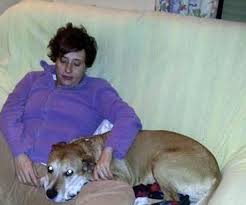QVC Host Loves Animals
Carolyn Gracie
 QVC's Carolyn Gracie loves her animals. Besides a house full of rescues, she was also quick to bring a pet into the QVC fold. "If you want to sell-out a product, bring a pet on TV with you," Carolyn advised. She regularly pitched products from small up-and-coming pet product entrepreneurs.
QVC's Carolyn Gracie loves her animals. Besides a house full of rescues, she was also quick to bring a pet into the QVC fold. "If you want to sell-out a product, bring a pet on TV with you," Carolyn advised. She regularly pitched products from small up-and-coming pet product entrepreneurs.
Carolyn Gracie's extensive broadcasting career began in 1981 as a radio announcer in Lafayette, Indiana. In 1986, she relocated to Los Angeles to be a radio host during the morning and afternoon drives at KOST and KBIG. Most people don't know that Carolyn Gracie was also instrumental in the start of Animal Radio, helping to get it on air at these stations in Los Angeles.
Carolyn was a program host for QVC. Animal Radio's own Dogfather, Groomer Joey Villani, had been on QVC selling his own line of grooming products, which did very well. Joey brought his own dog Miles as an assistant, and Carolyn said when you bring a really cute pet on the show, the item always sells out!
Carolyn would sometimes even bring in her own dogs to demo the products. She also tested some of the products at home with her pets. If they didn't pass the test with her own animals, they didn't make it to the show.
Carolyn's passion for animals led to several recognitions, including the Women in Business Award from the California State Legislature for her work as a broadcaster in support of pet rescue organizations. She also received the Wild Hearts Angel Award from the California Wildlife Center and volunteers at a number of pet rescues.
At home, Carolyn and her husband have dogs and cats, bunnies and chinchillas, all from shelters, and everyone gets along!
Sneezy, The Penn State Squirrel, Goes Viral
Mary Krupa, Squirrel Whisperer
 When Mary Krupa befriended a wild squirrel, she learned that she could easily dress "Sneezy" up and take photos of the rodent in hats and clothing. She then met up with the squirrel for photo sessions.
When Mary Krupa befriended a wild squirrel, she learned that she could easily dress "Sneezy" up and take photos of the rodent in hats and clothing. She then met up with the squirrel for photo sessions.
Sneezy, the Penn State Squirrel, became an Internet sensation and her Facebook likes soared. Sneezy had more likes on her Facebook page than the real Penn State mascot, the Nittany Lion.
So who is Sneezy? Sneezy is a squirrel that doesn't mind dressing up in tiny, adorable, handmade hats to be photographed.
It all started when Mary Krupa, a junior English major, with a minor in wildlife science, was having lunch with friends in front of Old Main on campus. The squirrel came up to them and appeared to be begging for food. Mary said the squirrel allowed her to touch it. This is not surprising, as the squirrels have become accustomed to being fed by the students.
After Sneezy let Mary touch her, Mary then thought the next step would be of course, to see if Sneezy would let her pet a hat on her head.
Mary has been putting little hats on Sneezy and taking her photograph for many years now. But how does Mary know it's the real Sneezy every time? Mary said she can tell the squirrels apart. She says they have different gaits and are different sizes. Even their facial structures and tails are different. But that's not all. Sneezy can recognize people as well and will sometimes seek out Mary.
 So how did she get the name Sneezy? Mary said she had to think about it in three seconds when someone saw her interacting with the squirrel and asked her what its name was. Mary hadn't yet named her, but Mary said she does tend to sneeze a lot when she is running around the dirt. So, Mary said her name was Sneezy, and it stuck.
So how did she get the name Sneezy? Mary said she had to think about it in three seconds when someone saw her interacting with the squirrel and asked her what its name was. Mary hadn't yet named her, but Mary said she does tend to sneeze a lot when she is running around the dirt. So, Mary said her name was Sneezy, and it stuck.
Mary tried to see Sneezy every day in between her classes.
Mary has done interviews on NPR, the Canadian Broadcasting Company and local television. USA Today mentioned Sneezy and Pepsi even came to shoot a promo with Sneezy, which unfortunately didn't work out, because Sneezy didn't show up!
Visit Website
The Twelve Days Of Christmas & The Eight Days Of Hanukkah
Lisa Hennessy, Your Pet Chef
 Lisa Hennessy decided she was done with commercial dog food for her Collie. She started creating healthy, fresh dishes that her dog could share with her. Lisa tested dozens of recipes and compiled them into several cookbooks. She's here to share some of her recipes with you.
Lisa Hennessy decided she was done with commercial dog food for her Collie. She started creating healthy, fresh dishes that her dog could share with her. Lisa tested dozens of recipes and compiled them into several cookbooks. She's here to share some of her recipes with you.
Lisa Hennessy started preparing special meals for dogs years ago when her rough collie, Shelby, was diagnosed with degenerative myelopathy. This disease caused her to lose control of her hind limbs.
Lisa's vet asked her if she would be willing to prepare a special diet for Shelby that had been designed by a leading veterinary researcher on this disease, which would help to slow it down. She said of course! She then began cooking the recipe.
At first, she thought there was no way her dog was going to eat this. The recipe included tofu, spinach, peppers, a combination that she said smelled like dirt. Well, to her surprise, Shelby gobbled it up!! She was stunned. Lisa then mixed this food with Shelby's regular kibble for a couple of weeks, gradually decreasing the kibble and increasing the "Shelby Food."
When the opportunity presented itself, Lisa started Your Pet Chef to share her love of preparing home cooked meals for her dogs with others.
Lisa said commercial dog food is filled with chemicals and fillers and is just plain junk! She says we would start seeing less medical issues than we have now with our pets if we just started feeding them a more natural, healthy diet.
 Lisa knows she is providing a complete and balanced diet for her dog, because she worked with her veterinarian on her recipes, so they are all vet-approved. She also rotates the proteins and rotates the organ meat, because each organ has its own key essential minerals, so that it is a balanced diet throughout the week.
Lisa knows she is providing a complete and balanced diet for her dog, because she worked with her veterinarian on her recipes, so they are all vet-approved. She also rotates the proteins and rotates the organ meat, because each organ has its own key essential minerals, so that it is a balanced diet throughout the week.
Your Pet Chef gathered some of the most popular Christmas dishes and adapted them for your dog in The Twelve Days of Christmas, as well as some of the post popular Hanukkah dishes and adapted them to your dog in The Eight Days of Hanukkah. All of Your Pet Chef meals are grain free, so they use that same philosophy with these recipes. Each day brings a new recipe and a fun story. They like to think of these books as an advent calendar for our dogs. Most recipes contain 5 ingredients or less so there's no excuse not to give them a try. Your dog is sure to love you even more and you can eat them along with your dog, if they are willing to share! Merry Christmas & Happy Hanukkah!
Visit Website
Circovirus Identified in Las Vegas Dog - Dr. Debbie

In 2013, there had been nationwide attention on the novel canine virus called Circovirus. The virus was thought to play a role in the illness and deaths reported in Ohio, Michigan and California. The disease causes diarrhea and vomiting, both which may become bloody. Symptoms can rapidly worsen and result in shock, bleeding disorders and in some cases death.
Sadly, there was news of a dog staying at a boarding facility in Las Vegas that became sick and subsequently died. The dog tested positive for Circovirus. Although this was a sad loss, it was fortunate that veterinarians were alert enough to send samples in for testing.
Research indicates that Circovirus may act as either a primary or perhaps a co-infection with other pathogens to cause illness. But the virus has been isolated from the stool of completely healthy dogs, so just because a dog tests positive for the virus, it doesn't mean it necessarily will get sick.
Much is not known of about Circovirus virus and how it may, or may not lead to disease in dogs. But the good news is that researchers are actively studying the virus, and practicing veterinarians are watchful for suspected cases.
Circovirus Background - What is Circovirus?
Circovirus is a virus affecting dogs that was first identified as recently as June 2012. Although Circoviruses are also known to affect pigs and birds, these are distinctly different than the canine Circovirus. As far as we know now, this virus does not affect cats.
What are symptoms of Circovirus?
Vomiting, diarrhea - which may be bloody
Rapidly worsening condition
Shock, fluid accumulation and bleeding problems

How is Circovirus spread?
The specific behavior of the virus is still being studied. But many other gastrointestinal agents are concentrated in the vomit and feces from infected dogs. Direct exposure to feces or vomit can transmit disease or contaminate surfaces or items.
How is Circovirus treated?
Just like Parvovirus in the 1980's, many gastrointestinal viruses have no specific cure but are treated with supportive care including intravenous fluids, antibiotics for secondary infections, and other therapies. Early in-hospital treatment was one important factor believed to improve survival for some earlier cases of suspected Circovirus.
Is there a vaccine?
A vaccine isn't available at this time.
What should pet owners do if their pet is showing symptoms?
It's important not to panic. There are many reasons why dogs develop vomiting and diarrhea. Dog owners should consult with your veterinarian if your dog develops symptoms consistent with Circovirus.
How can pet owners keep their dogs safe?
Pet owners should use good sense measures - clean up your pets waste, avoid contact with sick animals and keep up to date on other preventative measures like vaccines and dewormings.
Featured veterinarian known as "Dr. Debbie" on national pet radio program, Animal Radio. Ebook author of "Yorkshire Terriers: How to Be Your Dog's Best Friend"; "Pugs: How to Be Your Dog's Best Friend"; "Mini Schnauzers: How to Be Your Dog's Best Friend"; and "Shih Tzu: How to Be Your Dog's Best Friend." Dr. Debbie's books.
Visit Website
Animal Radio News with Tammy Trujillo
 Could Testing Cosmetics on Animals Be Banned In US?
Could Testing Cosmetics on Animals Be Banned In US?
Internationally, 44 countries have prohibited cosmetics animal testing, including every country in the European Union, Australia, Brazil, Canada, Colombia, Ecuador, Guatemala, Iceland, India, Israel, Mexico, New Zealand, Norway, South Korea, Switzerland, Taiwan, Turkey and the United Kingdom. In the United States, as of August 2023, 11 states (California, Hawaii, Illinois, Louisiana, Maine, Maryland, Nevada, New Jersey, New York, Oregon and Virginia) have passed laws banning the sale of animal-tested cosmetics. You can help eliminate testing on animals, by doing your research and boycotting companies who still test their products on animals.
Woman Spent $35,000 For Lost Dog
How much would you spend to try and find your dog if he got lost? I'm not talking about a reward here, but paying for the effort of finding him. The sky was the limit it seems for a woman and her Rotweiler mix who had been missing for many years. The dog owner spent over $35,000 dollars trying to find her dog, including printing thousands of signs and hiring four psychics and private eye dog investigators. Her dog was lost when he and his sister went on an off-leash run with in a Washington DC Reservoir. The dogs took off after a deer. One dog came back, but the other was still missing. Her story went national over the year, with some people saying she should give up. The owner said she didn't think about the money, just about finding her dog and bringing him home.
 Guardian Sued Over The Killing Of Her Dog
Guardian Sued Over The Killing Of Her Dog
A nurse in Spain who recovered from Ebola, but whose dog was killed by Spanish Health authorities, filled a lawsuit. The lawsuit sought the equivalent of $186,000 for the loss of her dog and another $186,000 for damage done to her name. Her dog was killed even though he showed no signs of the disease and despite an international petition to save him that had nearly 400,000 signatures. Unfortunately, the Supreme Court rejected her claim and ruled the killing justified.
Here's A Story Of How Much A Dog Can Love
A little Beagle mix named Buddy hitched a 20-mile ride on the step of an ambulance that was taking his person to the emergency room. This happened in in San Angelo, Texas. A driver flagged down the ambulance to let them know the dog was riding on the step. The ambulance crew stopped and brought the dog inside and he made the trip to the ER with his person, an 85-year-old man who had called the ambulance because he felt dizzy.
 Listen to the entire Podcast of this show (#1251)
Listen to the entire Podcast of this show (#1251)





